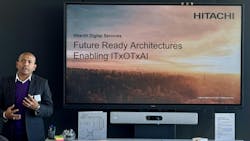Q&A: Roadmap to Industry 5.0 with Ganesh Bukka of Hitachi Digital Services
What you’ll learn:
- “Successful failures” of Industry 4.0—pilot projects that showed great promise but never quite scaled—showed efficiency and connectivity alone don’t guarantee success.
- What matters is bringing IT and OT together, preparing the workforce, strengthening cybersecurity, and building maturity around data and governance.
- In Industry 5.0, industrial edge AI empowers mission-critical systems to make decisions instantly.
Smart Industry recently spoke with Hitachi Digital Services’ Ganesh Bukka, the company’s VP and global head of Industry 5.0, about how Industry 4.0 is evolving for manufacturers into the Industry 5.0 future.
Bukka leads the company’s products and solutions efforts to help customers with their IT and OT digital transformations across various industry segments such as manufacturing, consumer, energy, and utilities.
See also: Q&A: Could a software vendor be on the hook if your company's systems get hacked?
Bukka lists his core competencies as incubating and scaling technologies such as AI, IoT, robotics, process automation, MES/MoM, PLM, autonomous mobility, EV, deep learning, additive manufacturing, and transforming to net zero.
He spoke a lot with Smart Industry about Industry 5.0 ideas and how critical successful IT-OT convergence is, the importance of AI-human collaboration, automation secrets to success, and cybersecurity.
This interview with Bukka is edited for length and clarity:
How can the “successful failures” of Industry 4.0 shape the roadmap for Industry 5.0?
Bukka: We’ve all seen the “successful failures” of Industry 4.0—those pilot projects that showed great promise but never quite scaled. They taught us something important: efficiency and connectivity alone don’t guarantee success.
See also: Q&A: Getting help: Why Seeq and other tech providers leverage so many partnerships
What really matters is bringing IT and OT together, preparing the workforce, strengthening cybersecurity, and building maturity around data and governance. A great example of this evolution is our Hagerstown Advanced Rail Digital Factory—where we’ve created what we believe is a cutting-edge model for Industry 5.0.
What are the key tenets for Industry 5.0?
Bukka: Industry 5.0 builds on five key ideas—human-AI collaboration, hyper-personalization and resilience, the industrial edge, the industrial metaverse, and sustainability. At Hitachi, we’ve been investing heavily in these areas, and our solutions really bring them to life.
See also: ‘Legacy’ cyber risk: How to prepare OT for system updates
Take our Automated Quality Inspection system at the Hagerstown Advanced Rail Digital Factory—it blends human-AI collaboration with industrial edge technologies.
Then there’s HMAX, which focuses on industrial AI and agentic intelligence, and RITA, our sustainability suite that helps clients drive their ESG goals. Together, these solutions show how we’re already helping our clients move confidently toward Industry 5.0.
In Industry 5.0, how can industrial edge AI transform real-time decision-making for mission critical systems?
Bukka: In Industry 5.0, industrial edge AI empowers mission-critical systems to make decisions instantly, right where the action happens. By processing data locally, it reduces delays, improves accuracy, and minimizes downtime.
What really matters is bringing IT and OT together, preparing the workforce, strengthening cybersecurity, and building maturity around data and governance.
- Hitachi Digital Services’ Ganesh Bukka
For example, our HMAX solution, used for critical systems such as trains, maximized performance by reducing downtime and driving cost efficiency, with these capabilities further accelerated through our partnership with NVIDIA.
What defines success in Industry 5.0?
Bukka: Success in Industry 5.0 isn’t just about rolling out IoT, AI, or automation—it’s about making them work at scale, with people, and for society. Real success means breaking down the silos between IT and OT, building data maturity and strong governance, strengthening cybersecurity, and, most importantly, keeping people at the center.
See also: How digital transformation and AI can redefine supply chains
For example, with one of our global automotive clients, we helped drive their manufacturing digital transformation—scaling these capabilities across multiple sites and proving what true Industry 5.0 impact looks like in action.
Can you share some success stories from Industry 5.0?
Bukka: Some of our standout Industry 5.0 projects include:
- An AR and ML solution for a global FMCG client that boosted frontline worker efficiency.
- Our IT-OT-AI innovations at the Hagerstown Advanced Rail Digital Factory, using GenAI-powered quality inspection, Spot robot dog, computer vision, and the industrial metaverse.
- RITA, our ESG reporting tool that helps clients drive sustainability.
- HMAX, which was used by one of our rail clients to optimize operations and reduce costs; and Digital Twin simulation for factory modelling, where we leveraged our partnership with NVIDIA and utilized NVIDIA Omniverse Platform for the solution.
About the Author
Scott Achelpohl
Head of Content
I've come to Smart Industry after stints in business-to-business journalism covering U.S. trucking and transportation for FleetOwner, a sister website and magazine of SI’s at Endeavor Business Media, and branches of the U.S. military for Navy League of the United States. I'm a graduate of the University of Kansas and the William Allen White School of Journalism with many years of media experience inside and outside B2B journalism. I'm a wordsmith by nature, and I edit Smart Industry and report and write all kinds of news and interactive media on the digital transformation of manufacturing.

